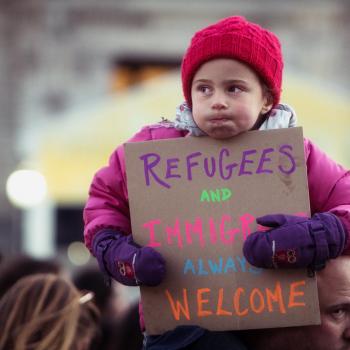With the annual March for Life only two months away, posters are going up in Catholic institutions, encouraging pro-life activists to make their travel plans in advance. We at the New Pro Life Movement have been talking about how to arrange our group’s presence at the March. It’s all a bit sudden, because our organization emerged only in recent months. It wasn’t something I had planned to initiate, though the seeds were planted deep in my past as a pro-life educator and feminist. And I hadn’t planned on attending the March. The financial expenditure I’d need to put forth to get there would be better spent, I thought, donating to charitable organizations or women’s care centers, or to women in crisis pregnancies, directly.
But, as several group members pointed out: we need that solidarity; we need to be visible, especially those of us who don’t fit the mold (Secular Pro-Life, Feminists for Life, PLAGAL, etc).
However, we want to keep in mind that marching isn’t everything. Ideally, yes, if you are pro-life you will engage in some form of pro-life work (education, counseling, volunteer work, political activism) – AND attend the March.
But if the March is the one pro-life thing you do all year long, maybe you should consider whether the money you spend attending it could serve the pro-life cause if it were donated to any of the organizations that work to provide women with the resources they need to choose life.
I would never say to anyone “don’t march.” However, I encourage pro-life readers to remember that making statements is not the ultimate end of being pro-life. Defeating the opposition is not the ultimate end. Making abortion illegal is not the ultimate end.
Saving lives is.
I have published here a note from New Pro Life Movement member, H. Lillian Vogl, explaining why she did not attend the 2016 March for Life:
Why I DON’T March (Because I Am Ardently Pro-Life)
There are lots of concerns bubbling up about the March for Life being held as scheduled just as the first snowflakes of an historically severe blizzard hitting Washington DC begin to fall. Is it heroically pro-life to march in spite of the weather or an ironic disregard of life to risk the inevitable traffic accidents?
I firmly am in the latter camp, but I do have a confession to make: even though I have lived within 30 miles of Washington DC for 15 out of the last 19 Januarys (and even worked in DC for several of those years), I have never attended the March for Life, regardless of the weather. Many of my friends are perennial marchers; some of them even get in front of the TV cameras to speak out for the unborn. I absolutely support their message, but I don’t see the point of participating in the March myself. I am sure there are some young people who go to the March because all their friends are doing it, and it inspires them to get involved in the pro-life movement too, and that is wonderful. But I was inspired a different way as a youth to be ardently pro-life, and it is that different path that makes me disinterested, and in some respects even disappointed, in the March for Life.
It began when I was 10–11 years old, and my mother had to have a complete hysterectomy due to severe endometriosis. My father’s 22-year-old half-sister, who had recently dropped out of college and was listing about doing nothing (before the days when that’s what most 22-year-olds did), was dispatched from halfway across the country to help around the house while my mother convalesced. It turned out she was no more interested or dedicated to cooking, washing dishes, or handling laundry than she was with her Pre-Med college courses. After a couple of months of more arguing than helping, my mother started driving her around looking for jobs, none of which stuck for more than a couple of weeks. Finally my aunt decided to enroll in the Art Institute to pursue fashion design studies, and we helped her move into the dorms downtown.
Soon my aunt met a guy who gave her the attention and acceptance her own parents would not, and she moved in with him. We visited their apartment once and it reeked of cat urine and beer. Then she got pregnant. Her mother told her to get an abortion and sent her the money to do it. Her boyfriend told her to get an abortion. But she had taken advanced biology, and had a conscience though not discipline, so she knew the baby inside her was a human person and did not want to abort. Her boyfriend kicked her out of the apartment for refusing. She frantically called our house from a payphone; my mother immediately drove downtown to pick her up and bring her back to our house.
My parents wanted to help, but they already knew she was too disruptive to our family life to stay with us long term. This time my mother drove her around to crisis pregnancy centers, looking for help. The first one gave my aunt a lecture about the development of her child in the womb, which she already knew, and that was all. The second did the same. Finally my mother found a program that placed unwed mothers with families for the duration of their pregnancy, and my aunt moved in with another family in the metro area for several months before giving birth and giving her infant girl up for adoption.
My best friend and I discussed all these things, and they cemented our early commitment to pro-life action. A few years later we attended the National Right to Life conference together and got equipped for action before going off to college—me to a small Christian college and her to Princeton.
My freshman year in college I signed up to participate in a pro-life activism training weekend at a larger Catholic college. They bused us to an abortion clinic and handed out large placards with gruesome pictures of aborted babies printed in huge horrifying color. After a couple hours standing in the cold with these signs, they bused us to the suburban neighborhood of an abortion doctor and gave us pamphlets to hand to people out walking their dogs, informing them of the infamy of their neighbor. I felt sick. This is not what saved babies’ lives! This was the kind of uncharitable response that had turned my aunt’s mother, who had an abortion as a young woman herself, defiantly pro-abortion. I never participated in an abortion protest again.
My best friend started college the next year, and she volunteered as a tutor for underprivileged high school students in Trenton. A few months in, the girl she was tutoring confided in my friend that she was pregnant, so my friend began putting her pro-life training to use to convince her not to abort. The girl was threatened with being kicked out of her house, so my friend started looking for residential programs to help her. At the time the internet was just a trickle of bits that delivered this new thing called e-mail on green and black screens, so it was not easy to track down these resources. My friend prayed and called around frantically for a week or two, until another woman who mentored the girl took her to go get an abortion. Help, if there was any to be had, was too late.
The pro-life movement has gotten better at providing practical support for women in crisis pregnancies since the 1980s and 90s, to be sure. But I still believe we put too much money and effort into making statements—statements that too often backfire, but even when they are benign are only statements. Meanwhile, the one maternity home I know of in Washington DC struggles to stay afloat financially, as does the pro-life ObGyn practice that serves all of the crisis pregnancy clients in Northern Virginia.
Around 500,000 people participate in the March for Life in DC in typical years. Taking a conservative estimate that it takes $100 per person on average for that to happen – money for gas, hotels, meals, public transportation, and event staging costs – that would be easily $50 million per year spent on attending the March for Life in Washington DC alone. What if that money were used to endow a new maternity home in each state every year? What if that money were used to buy more mobile sonogram centers or pay the salaries of pro-life doctors who have dedicated themselves to serving poor mothers and babies? Do you think that would save more lives than continuing to tout attendance at the national March for Life as the sine qua non of being devotedly pro-life?
I put my money where my mouth is. I gave thousands of dollars a year to local pro-life services, until I experienced a mini-crisis pregnancy of my own. I was laid off from my well-paid job shortly after I found out I was pregnant with my second child, and the school where my husband was teaching was shut down in the middle of my pregnancy too. A pro-life Washingtonian had pity on me and gave me a temporary job when I was nine months pregnant. Six years and a few jobs later I still make half what I used to, so my giving to local pro-life groups has dwindled to the hundreds instead of thousands, but if I could afford to give more I would do it in a heartbeat.
And there is another thing greatly bothers me about the pro-life movement, which is that we don’t do more to address the circumstances that cause women to be in crisis pregnancies. Every time I’ve been in a woman’s bathroom in a Catholic church I see fliers for support for women who are considering or recovering from abortion. But why do they turn to abortion? Often because there is emotional and sometimes even physical abuse in their lives, or financial desperation. They may be living with a boyfriend because they have been rejected by or are escaping their parents. They may be stuck financially dependent on their husband or boyfriend who has turned abusive. They may be between jobs with no means of financial support. Should we not be addressing abortion at its root causes? So why have I never seen (except at one university parish) any fliers for women seeking safety or counseling from an abusive relationship, or help finding employment, in those same ladies’ rooms?
The hearts and lives of women walking down the streets in Washington DC are not transformed by seeing crowds of young faces—mostly from stable happy families who cannot imagine the deep crisis of abuse or long-term unemployment—waving signs around, even if the messages on the signs are positive. They are transformed when they know they have someone to go to when they feel desperately alone and hopeless. They are transformed when they are given help finding gainful employment, and guaranteed that they can keep that employment while they give birth and nurse their baby and raise their child. They are transformed by person-to-person acts of mercy. I hope that the young people marching truly understand that, but I fear too many don’t.
That is why I do not march, but I do take some time to write this, and to send a donation to Students for Life for cancelling their conference to send the students home early to safety and give their pre-ordered meals to the homeless in DC. Because I am ardently, passionately pro-life.












